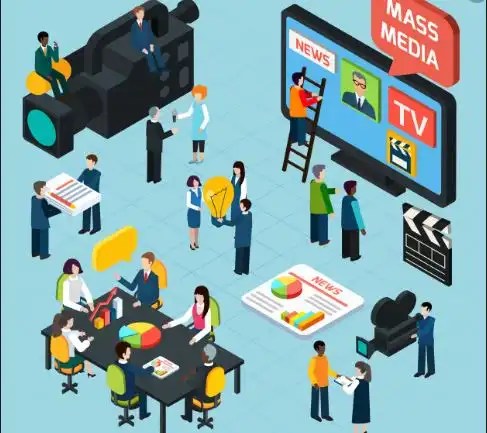
What is Mass Communication? Mass Communication contains two broad terms – “Mass” and “Communication”. The term “Mass” denotes large volume, great extent or range (of people or production). The Oxford Advanced Learner’s Dictionary defines it as “a large amount of a substance that does not have a definite shape of form; a large number of people or things grouped together”. Communication, on the other hand, refers to the act of transmission and reception of messages. It entails the notions of response, sharing
and interaction. The Oxford Advanced Learner’s Dictionary defines it as the “activity or process of expressing ideas and feelings or giving people information.”
If we juxtapose these two terms, we have mass communication which, according to Wikipedia, the free on-line encyclopedia, is a term used to describe the academic study of the various means by which individuals and entities relay information through the mass media to large segments of the population at the same time.
It is usually understood to relate to newspaper and magazine publishing, radio, television, film and today, the Internet.
Thompson (1995) defines it as an institutionalized production and generalized diffusion of symbolic goods via the fixation and transmission of information or symbolic content.
According to him, the system of information codification has shifted from analog to digital. Communication between individuals has since advanced with the existence of Infrared, Bluetooth and Wi-Fi. It is now possible to transmit or transfer Photographs, music, documents, games and e-mail at the same time and anywhere.
various definitions of mass communication today available on the Web include:
i) Mass Communication makes it possible for every citizen to be continuously exposed to a rain of information concerning current happenings and a hail arguments.
ii) Mass Communication is Downfall Road’s first album.
iii) Mass Communication is the term used to describe the academic study of the various means by which individuals and entities relay information through the mass media to a large segment of the population at the same time.

MASS COMMUNICATION AS A FIELD OF STUDY
Mass Communication is an academic field of study, categorized into various levels of academic or intellectual experience.
The course is offered at Pre-Diploma, Diploma, Higher Diploma, First Degree and Postgraduate levels in numerous formal and extended institutions. You can also look up some of the best mass communication professional courses that might help you grow in this field.
Extended institutions are those that offer ex-campus learning opportunities, done largely today with on-line facilities.
Research in mass communication includes media institutions and processes such as diffusion of information and media effects like persuasion or manipulation of public opinion (Wikipedia).
In universities, particularly in the United States of America, the Journalism departments fall into the structure of schools or colleges of mass communication or “journalism and mass communication”.
Mass Communication students are taught practical skills of journalism, graphic arts, public relations and advertising. Other aspects are journalism practice, history, law and media effects.
Mass Communication as an academic discipline differs from Media Studies and Communication Studies programmes which have their roots in departments of theatre arts, film or speech. The interest here lies in “qualitative” interpretive theory and critical or cultural approaches to communication study, while mass
communication programmes lean towards empirical analysis and qualitative research /-/ from statistical content analysis of media messages to survey research public opinion polling and experimental research.
Graduates of mass communication programmes can get employment in traditional news media and publishing, advertising, marketing communication, public relations and research institutions.
THE DEVELOPMENT OF HUMAN/MASS COMMUNICATION
According to McQuail (1975), human communication is the process of sending meaningful messages from one person to another. The message could be basically oral or written, visual or olfactory. He identifies methods of communication as laws, practices, customs, ways of dressing, gestures, military parades and flags.
Development in human communication was earlier driven by the process of mankind’s evolution from lower species and later by progress made in the field of technology.
The main stages are:
1. The Age of Signs and Signals
Communication during the prehistoric human era was largely limited and determined by instincts. Smoke signals, music, dance and drum messages were the key methods of communication in that era.
2. The Age of Speech and Language
Man’s ability to develop speech and language was a major achievement that placed man at the higher hierarchy to other animate beings. The development of different languages distinguished one community from another. The language of conquerors was usually absorbed into the local dialects of the conquered and became the language of administration, commerce and socialization.
3. The Age of Writing
The development of hieroglyphic writing by the Mayan and the Chinese enabled pictures with standardized meanings to be used in communication. The Sumerians developed a different forms of writing that represented sound by a symbol. With this, information could be stored and tradition passed on in writing. Writing gave
permanence to the spoken language. Clay, stone, and papyrus were used as portable media.
4. The Age of Print
Paper was invented in China in the 1st Century CE. By the 8th Century, the Arab World had begun to manufacture paper, while the movable printing press was invented in Guttenberg in the 15th century CE. Thus printing began in Europe.
That single development enabled information to be copied much faster and with far fewer mistakes than ever before. The consequence of that development is that wider section of societies today has unrestricted access to information.
5. The Mass Communication Age
Several forms of communication media were developed in the 19th century. They include print media such as newspapers, and wireless media like telegraph and telephone. The introduction of radio, film and television in the 20th Century saw the emergence of the mass communication era. It was at this point that mass communication, as we know it today, developed.
6. The Age of Information Revolution
The era in which we now are is commonly referred to as the Information Age.
The key features of this era are:
– Integrated multi-media application:
– Network communication;
– Digital communication technology; and
– Hypertext and similar interactive formats.
In summary, the history of mass communication is as old as humanity. Overtime, the means of Mass communication has evolved as new technologies have made reaching out to a wider audience much easier with just a click of a button through the advent of social media and other audio visual means. Mass communication is so large that recently in Nigeria, the federal ministry of Education through the NUC announced that Mass Communication as a course will not be studied whole, rather in branches as this is due to the scope of this course.



